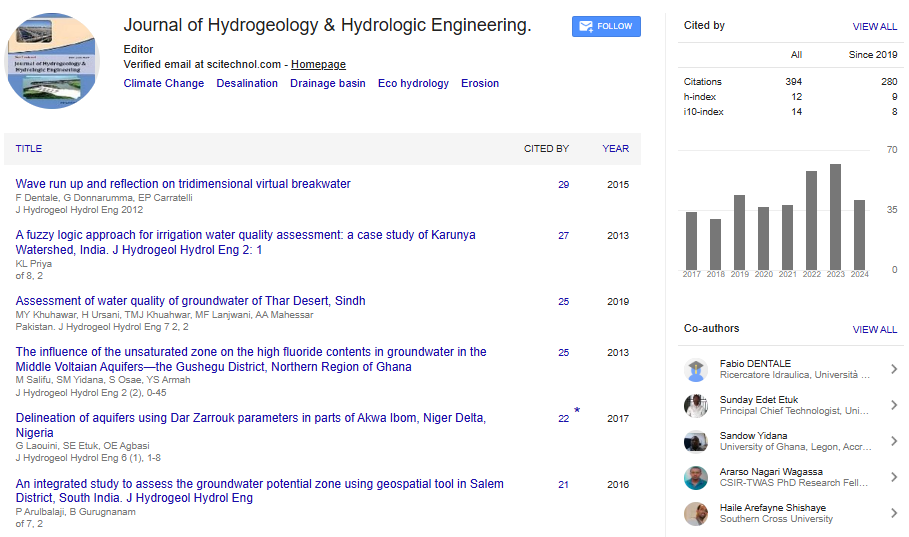Commentary, J Hydrogeol Hydrol Eng Vol: 13 Issue: 5
The Essential Resource Under Our Feet: An Examination of Groundwater Quality and Analysis
Amara Ndiaye*
1Department of Ecohydrology, University of Cambridge, Cambridge, United Kingdom
*Corresponding Author: Amara Ndiaye,
Department of Ecohydrology, University
of Cambridge, Cambridge, United Kingdom
E-mail: ndiayea24@gmail.com
Received date: 23 September, 2024, Manuscript No. JHHE-24-153110;
Editor assigned date: 25 September, 2024, PreQC No. JHHE-24-153110 (PQ);
Reviewed date: 09 October, 2024, QC No. JHHE-24-153110;
Revised date: 16 October, 2024, Manuscript No. JHHE-24-153110 (R);
Published date: 24 October, 2024, DOI: 10.4172/2325-9647.1000346
Citation: Ndiaye A (2024) The Essential Resource Under Our Feet: An Examination of Groundwater Quality and Analysis. J Hydrogeol Hydrol Eng 13:5.
Description
Groundwater is an essential resource, supporting nearly half of the world’s population for drinking water and sustaining agricultural and industrial activities. With increasing reliance on groundwater, especially in arid and semi-arid regions, ensuring its quality has become dominant. Groundwater quality directly affects human health, ecosystems and the economy, making its analysis essential for sustainable resource management.
Primary factors in groundwater
Groundwater quality refers to the composition of groundwater in terms of its chemical, physical and biological parameters. This composition is influenced by natural factors, such as the geology of the region and the rate of water movement, as well as anthropogenic activities like agriculture, industrial discharge and urban development.
The primary factors that influence groundwater quality include:
Geology and soil composition: Different minerals and rock formations release specific ions and minerals into groundwater, affecting its pH, hardness and other parameters.
Land use practices: Agriculture, industry and urbanization introduce various pollutants into the groundwater, including pesticides, nitrates, heavy metals and industrial chemicals.
Hydrology and recharge rates: The amount and rate at which groundwater is recharged by rainfall or surface water can dilute or concentrate pollutants.
Human activities: Excessive extraction, poorly managed landfills and wastewater discharge contribute to groundwater contamination, impacting its quality.
Common contaminants in groundwater
Groundwater is prone to contamination from a wide range of pollutants. Some of the most common contaminants include:
Nitrates: Often from fertilizers and sewage, high nitrate levels can be harmful, particularly to infants, leading to conditions like methemoglobinemia.
Heavy metals: Arsenic, lead, cadmium and mercury, often from industrial processes, mining and wastewater, can cause severe health issues if consumed over long periods.
Pathogens: Bacteria, viruses and parasites from sewage leaks or agricultural runoff can cause waterborne diseases.
Organic chemicals: Pesticides, solvents and industrial chemicals are hazardous and can persist in groundwater, causing long-term contamination.
Importance of groundwater quality analysis
Analyzing groundwater quality is essential for several reasons:
Human health protection: Consuming contaminated groundwater poses serious health risks, including gastrointestinal, neurological and developmental disorders.
Agricultural sustainability: Water quality affects crop health and yield. High salinity or toxic metals can damage soil health and crop viability.
Environmental conservation: Poor-quality groundwater can degrade ecosystems. Toxic substances can seep into rivers, lakes and oceans, affecting aquatic life and biodiversity.
Resource management: Groundwater analysis aids policymakers and environmental agencies in implementing regulations, tracking pollution sources and planning sustainable extraction.
Methods of groundwater quality analysis
Groundwater quality analysis involves collecting water samples and examining various parameters using advanced techniques. Some standard methods include:
Physical analysis: Involves measuring temperature, turbidity, color and conductivity. High conductivity might indicate the presence of dissolved salts, while turbidity may suggest suspended particles.
Chemical analysis: Measures dissolved substances, including major ions (e.g., calcium, magnesium), pH levels, hardness and Total Dissolved Solids (TDS). Advanced chemical testing can detect trace elements and organic pollutants.
Biological analysis: Tests for pathogens, bacteria and other biological agents. It often involves microbial testing techniques to ensure that groundwater is safe for human consumption.
Technologies like spectrophotometry, chromatography and atomic absorption spectroscopy help in identifying and quantifying specific contaminants.
Challenges in groundwater quality management
Over-extraction and decline in quality: Excessive groundwater extraction can lead to reduced recharge rates, resulting in higher concentrations of contaminants.
Diffuse pollution sources: Agricultural runoff and other non-point sources of pollution are challenging to monitor and control due to their dispersed nature.
Lack of monitoring infrastructure: Many regions lack the facilities and expertise to conduct regular groundwater quality assessments, leading to undetected contamination.
Climate change impact: Climate change influences precipitation and recharge patterns, affecting groundwater quality due to increased concentrations of pollutants during droughts.
Conclusion
Groundwater quality and its systematic analysis are essential for protecting public health, supporting agriculture and conserving ecosystems. Comprehensive groundwater analysis allows for informed decision-making, regulation of contaminants and the development of sustainable practices. By improving monitoring infrastructure and embracing innovative analysis methods, we can safeguard this vital resource for future generations. Addressing groundwater quality issues requires a collaborative approach among government agencies, scientists and communities, emphasizing the need for sustainable management of this invaluable resource beneath us.
 Spanish
Spanish  Chinese
Chinese  Russian
Russian  German
German  French
French  Japanese
Japanese  Portuguese
Portuguese  Hindi
Hindi 
